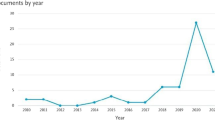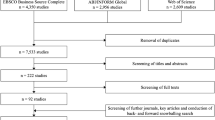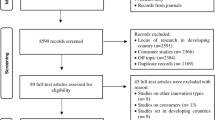Abstract
Shrimp aquaculture constitutes a major economic activity of some middle- and low-level economies in the world. Though it is practiced by around 70 countries, it is primarily dominated by China, Thailand, Indonesia, Vietnam, Ecuador and India. These six countries account for 80 % of the global shrimp production. The study has highlighted the role of research in the development of the industry by taking the examples of Penaeus vannamei and P. monodon. In case of the former, a seven time rise in quantum of research (studied by the number of publications as a proxy) could induce five time increase in production, whereas, in the latter case similar pattern was not noticed. The study has observed that based on shrimp production and research contribution; the major 30 countries associated with shrimp aquaculture could be categorized as: (i) high production, high-research contribution, (ii) low production, high-research contribution and (iii) high production, low-research contribution. The countries under the third category are at great risk and may suffer huge economic losses in the event of outbreak of any disease. By generating network map of research linkage across different countries the study has highlighted the potential countries for strengthening the existing linkage and fostering new linkage for knowledge consolidation. The study has given some suggestion for policy formulation for achieving a rapid growth of shrimp aquaculture in the world.








Similar content being viewed by others
Notes
The Durbin–Watson statistic is a test statistic used to detect the presence of autocorrelation (a relationship between values separated from each other by a given time lag).
References
C.I.A. The World Fact Book. www.cia.gov/library/publications/the-world-factbook/geos/as.html. Accessed 25 Nov 2011.
Dastidar, P. G. (2004). Ocean Science & Technology Research across the countries: A global scenario. Scientometrics, 59(1), 15–27.
Dastidar, P. G., & Ramachandran, S. (2005). Engineering research in ocean sector: An international profile. Scientometrics, 65(2), 199–213.
Dastidar, P. G., & Ramachandran, S. (2008). Intellectual structure of Antarctic science: A 25 year analysis. Scientometrics, 77(3), 389–414.
Department of Science & Technology (DST). (2002). Research & Development Statistics. 2000–2001 (p. 52). New Delhi: DST.
Food and Agriculture Organization of the United Nations (FAO) (2012). State of world aquaculture www.fao.org/fishery/topic/13540/en. Accessed 22 April 2012.
Food and Agriculture Organization of the United Nations (2011). Fisheries and Aquaculture Department FishStatJ—software for fishery statistical time series.
Freeman, L. C. (1979). Centrality in social networks: conceptual clarification. Social Networks., 1, 215–239.
Hanneman R. (2006). Introduction to social network methods. www.faculty.ucr.edu/~hanneman/. Accessed 22 June 2006.
Kalam, A. P. J., & Singh, S. P. (2011). Target 3 billion, Pura: Innovative solutions towards sustainable development. New Delhi: Penguin Books.
Karunasagar, I., & Umesha, R. K. (2005). Microbial diseases in shrimp aquaculture. In N. Ramaiah (Ed.), Marine microbiology: Facets & opportunities (pp. 121–134). Goa: National Institute of Oceanography.
Lifestyle Lounge: Health & Fitness. Nutritional value of shrimps. www.lifestyle.iloveindia.com/lounge/nutritional-value-of-shrimps-6514.html. Accessed 22 April 2012.
Lightner, D. V. (1999). The penaeid shrimp viruses TSV, IHHNV, WSSV, and YHV: current status in the Americas, available diagnostic methods and management strategies. Journal of Applied Aquaculture, 9, 27–52.
Lightner, D. V., Durand, S. V., Redman, R. M., et al. (2001). Qualitative and quantitative studies on the relative virus load of tails and heads of shrimp acutely infected with WSSV: Implications for risk assessment. In C. L. Browdy, D. E. Jory (Eds), The new wave, Proceedings of the special session on sustainable shrimp culture (pp. 285–91). Baton Rouge, Aquaculture, The World Aquaculture Society.
Lightner, D. V., & Redman, R. M. (1998). Shrimp diseases and current diagnostic methods. Aquaculture, 164(1–4), 201–220.
Mukherjee, K., & Mandal, N. (2009). A microsatellite DNA Marker developed for identifying disease resistant population of Giant Black Tiger Shrimp (Penaeus monodon). Journal of the World Aquaculture Society, 40(2), 274–280.
Natalie, F., Fiore, G., & Hofherr, J. (2012). Mapping the research on aquaculture: A bibliometric analysis of aquaculture literature. Scientometrics, 90(3), 983–999.
Newman, M. E. J. (2001). The structure of scientific collaboration networks. Proceedings of the National Academy of Sciences, 98(2), 404–409.
Pajek 1.18 http://vlado.fmf.uni-lj.si/pub/networks/pajek/.
Pillay, T. V. R. (1998). Aquaculture principles and practices. Oxford: Fishing News books.
Scopus. www.scopus.com/home.url. Accessed 7 Dec 2011.
The World Bank. GDP per capita (current US$). www.data.worldbank.org/indicator/NY.GDP.PCAP.CD/countries. Accessed 25 Nov 2011.
Thomson Reuters. www.apps.webofknowledge.com/WOS Advanced Search, Accessed 7 Dec 2011.
UNESCO. Table Viewer from www.stats.uis.unesco.org/unesco/TableViewer/tableView.aspx?ReportId=2011. Accessed 25 Nov 2011.
Wasserman, S., & Faust, K. (1994). Social network analysis, methods and applications. Cambridge: Cambridge University Press.
White, K., O’Neill, B., Tzankova, Z. (2004). At a crossroads: Will aquaculture fulfil the promise of the blue revolution? A Sea Web Aquaculture Clearinghouse report.
Wyban, J. (2009). World shrimp farming revolution: Industry impact of domestication, breeding and widespread use of specific pathogen free Penaeus vannamei in the rising tide, In: Proceedings of the special session on sustainable shrimp farming, World Aquaculture 2009. The World Aquaculture Society, Baton Rouge Louisiana.
Acknowledgments
The research has been supported by the Ministry of Earth Sciences (MoES), Government of India. Authors are grateful to Dr B S Agrawal for his valuable suggestions and editing the manuscript.
Author information
Authors and Affiliations
Corresponding author
Additional information
Prabir G. Dastidar and Ajoy Mallik have contributed equally to this study.
Rights and permissions
About this article
Cite this article
Dastidar, P.G., Mallik, A. & Mandal, N. Contribution of shrimp disease research to the development of the shrimp aquaculture industry: an analysis of the research and innovation structure across the countries. Scientometrics 97, 659–674 (2013). https://doi.org/10.1007/s11192-013-0977-9
Received:
Published:
Issue Date:
DOI: https://doi.org/10.1007/s11192-013-0977-9




